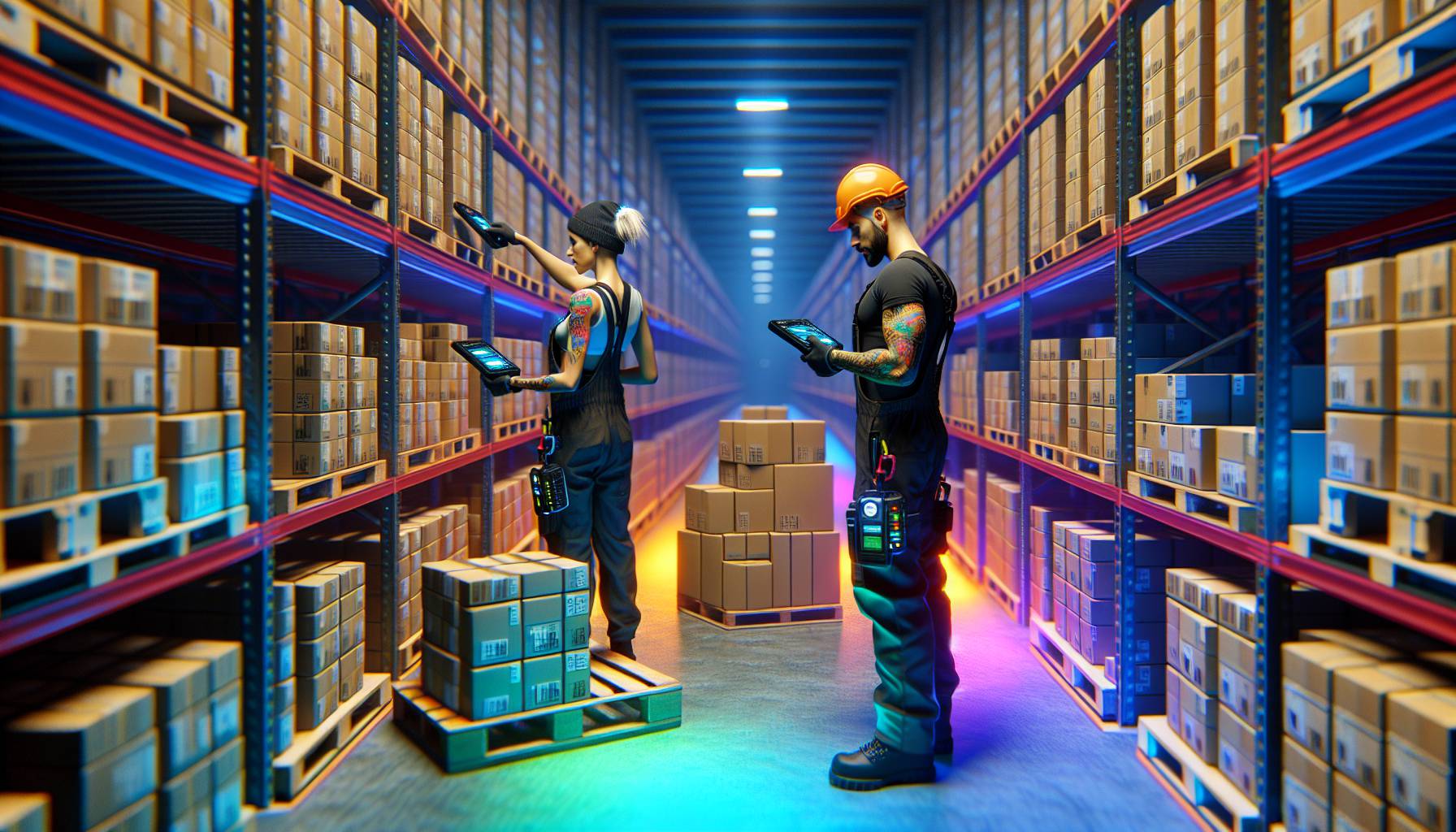Understanding the Importance of Inventory Management

I've always thought that controlling stock was like being a bit of a puppet master. All those strings - some attached to products, some to suppliers, some to customers. Most are tied up in money. It's about seeing the bigger picture, like peering into the middle distance and knowing, with frightening accuracy, just how much you have, what you're selling and what you're going to need for tomorrow.
Good inventory management can help avoid either overstocking or running out of products at exactly the wrong time. If you don't know how much you have in your warehouse, then it could be tricky delivering stuff quickly to customers who are quite possibly impatient but very loyal. And if there's one thing I know about customers, it's that they get annoyed when they can't get what they want and they'll simply go elsewhere if things take too long.
So efficient inventory tracking reduces wait times. Sort of.
It's not even just about keeping track of supply and demand either - it's about being able to look at sales data, see which products are somewhat flying off the shelves and which aren't, then perhaps adjusting your supply chain decisions based on all of that. This helps a business make sense of profits by keeping track of how much it's spending and earning while also identifying any possible waste due to poor stock control. I think this makes it easier to give consumers high-quality goods at fair prices.
It seems like successful businesses today are the ones who build relationships with their customers based on trust and positive associations while effectively managing what's happening behind the scenes too. And most of this comes down to having an effective inventory management system that ensures reliability across all fronts. In the modern business world, where consumer expectations are becoming less accommodating, having a more proactive approach towards keeping your inventory in check will make all the difference in growing your customer base for years to come.
Implementing Real-Time Tracking Systems

It seems like the entire world has gone rather digital these days, and it appears retailers haven’t been left behind. In fact, they appear to be leading the pack, especially when it comes to stock control. These days, inventory management is rather all about implementing tech-driven solutions like real-time tracking systems for smarter stock control.
It goes a lot deeper than barcode scanning and inventory apps, which are now so five years ago. Today, retailers are a bit turning to radio frequency identification (RFID) and internet-of-things-enabled (IoT) sensors to get data on their stock down to the very last item. But even QR codes go a long way in helping warehouse and storefront teams monitor their stock, so it doesn’t have to be overly complicated. And I suppose that’s the point with real-time tracking systems.
It’s not about doing more, it’s about being able to see what you’re doing so you do it better. With real-time tracking, teams can quickly see things like where shipments are in the supply chain or which items sell out fastest to not only keep up with customer demands, but also prevent wasteful overstocking and even guide pricing decisions based on demand. One might think this all seems like quite a bit of work for good old-fashioned stock-taking, but having a single dashboard that shows what’s going where, when is a game-changer for retail teams with hundreds (or thousands. ) of stock-keeping units (SKU) across dozens of stores.
This doesn’t just help with things like products missing from shelves - but also with customer service and experience levels on the floor, resulting in more sales for every SKU. I suppose it really comes down to what retailers value more: their customers or their own teams. Because while customers may not be too keen to accept ‘the system says we have one in stock, but I can’t seem to find it’ as an answer, chances are their retail teams aren’t either.
Utilizing Data Analytics for Demand Forecasting

The way I see it, there’s been this fairly awkward trend for years where people act shocked that data is the answer to everything. I Expect aren’t we in 2024 now. If you haven’t already realised that cold, hard numbers are what control modern retail, then i’m not sure what to tell you.
Except maybe look around - there are 10-year-olds reading out python codes on Reddit. But also, data analytics is important. It makes sense that you want to base your business decisions on evidence rather than hope - although a little of the latter is necessary sometimes. And demand forecasting is hardly ever really quite crucial since you don’t want to run out of stock just when demand explodes or keep excess inventory and have it go to waste.
Data helps here too. It helps everyone everywhere really. Yet, I suppose it’s nice to know that data analytics can often actually be used by people without a PhD in maths or computer science.
It’s become easier than ever to get access to all the information that impacts your inventory management right from your favourite accounting tool or POS system. More or less. They’re all collecting and interpreting data faster and better than ever before, so you don’t have to worry about those returns anymore. It’s a good idea though to not take these reports at face value either, despite how comprehensive they may appear.
You’re getting a calculated output, but it may not always account for certain factors that don’t yet fit into the forecast model - economic slumps, cultural events, political instability, even drastic climate changes or war in some cases; all of these can impact demand and therefore your inventory needs too. So I’d say keep your mind as open as possible and use everything at your disposal (including good old gut instinct) to forecast inventory demand as best as possible for your needs right now.
Streamlining Your Supply Chain Processes

It seems like the word ‘streamlining’ has been bandied about for quite a while now. As a word, it promises much – making things easier, moving them along swiftly, running like a well-oiled engine. For a word that sounds quite flippant, it actually requires a great deal of planning, strategising and patience.
More or less. And why wouldn’t it. If you want to be able to get your products into the hands of customers effortlessly, you need to look at the little cogs in your very big fashion supply chain. It’s all about working smarter, not harder.
Invest in an inventory management system that works for you and your business rather than you working for it. Make regular reviews of your best-selling and slow-moving products and update your system accordingly to keep waste down and profits up. More or less. While supply chains are not always predictable and most often not within our control, having a strong relationship with your suppliers can go a long way in smoothening out chinks in your chain.
Sharing your sales projections and inventory data with them can also help them support you better especially during those unplanned busy periods – think festival season or just before Black Friday. And while you’re sharing data with them, maybe ensure that the information you have is accurate.
No point relying on outdated numbers to make stock decisions. All this planning will make sure that your shelves are relatively stocked enough to avoid product shortages or overstocking but more importantly keep profits up and wastage down. Streamlining sounds quite good when you think about it this way.
Adopting Automation Tools for Efficiency

What a time to be alive - where robots can hold conversations with us, and automation tools are ready to do all the heavy lifting. Technology has made great strides in recent years, and you’d be better off leveraging this fact for better business outcomes. It is time to work smarter, not harder. Using technology to automate inventory management and fulfilment can somewhat greatly boost efficiency while reducing the potential for human error.
The options for automation seem endless, and different businesses prefer different tools depending on their size and needs. The good thing is that you can get started with the basics.
For instance, there are quite a bit automated reorder points or alerts that help businesses reorder when their stock levels go below a certain point. There’s also the advanced radio frequency identification (RFID) technology that uses electromagnetic fields to track inventory and gives access to information like quantity, location, movement and history - all in real time.
Automation tools such as warehouse management software (WMS), electronic data interchange (EDI), order fulfilment systems, point of sale (POS) systems, barcode scanners and other apps like Zoho Inventory or Lightspeed Retail POS are other useful options to explore. Sort of. But that’s not all - you could even try AI-powered analytics solutions that predict demand, reorder automatically and even monitor supplier performance.
When adopting automation tools, it is important to research thoroughly and pick solutions best suited for your business based on your current pain points as well as future needs. While automating inventory control can feel intimidating at first, it brings a plethora of benefits such as improved accuracy, less manual intervention and reduced costs over time. That’s more than enough reason to get started today - before we’re all replaced by AI tomorrow.
Regularly Reviewing and Adjusting Stock Levels

It’s not just a matter of watching the numbers drop each day - those little barcode scanner beeps at the point of sale can’t do the thinking for you. While it seems easier to rely on auto-alerts or last-minute calls from your store manager, in reality it is vital that this is done with good old fashioned attention to detail. I think of stock as living, breathing entities that transform in both value and usability with time.
To keep things running smooth like a fresh batch of honey from the hive, maintaining a regular physical and digital review routine can help you see the big picture before it arrives. But what about all those times you get a call in the middle of a meeting about how your signature product is out or when an item with an outdated label gets delivered to a customer.
I find that regularly reviewing stock levels - once a week, or even twice - lets you know when things are going awry. It’s also about creating an opportunity to go into your warehouse and look at the stock first hand; check batch numbers, expiry dates, delivery notes and also just that everything matches up. In doing so, it’s easier to catch any small but crucial discrepancies which come back to bite later.
In addition to creating a regular physical inspection routine, there are plenty of ways you can use clever technology to make this process easier. Barcodes, POS software and robust e-commerce stock plugins can help you identify supply chain issues much faster than waiting for a customer complaint. Regular reviews can give you time to train your team to identify mistakes early on as well as create smarter ways for them to take charge of their own inventory review and movement. Of course, there will always be moments where you are short on staff or have higher priorities, but this doesn’t mean skipping an inventory review.
When you’re looking to scale your business in any way, chances are that more people are going to ask for more information about what you carry and how much value you can offer. I think that at the end of the day, knowing where your products are at any given time - physically and digitally - is key for sustainable growth.


